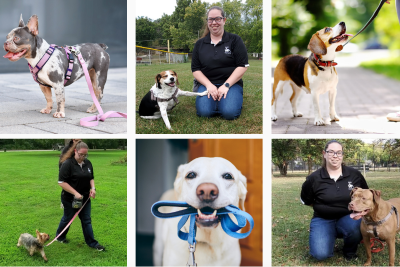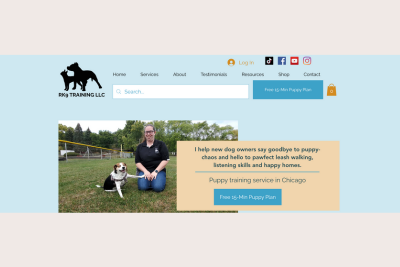Disclosure: Some articles on this site may contain affiliate links, meaning, at non additional cost to you, Chicago Urban Pets may earn a commission if you click through and make a purchase. As an Amazon Associate we earn from qualifying purchases.
Kelly from RK9 Training, a seasoned professional in the world of dog training, engages in a lively conversation with Stephanie, the enthusiastic owner of Chicago Urban Pets. As their paths converge, a wealth of knowledge and experience intertwine, creating the perfect atmosphere for a fruitful exchange on the art of dog walking.
Join them as they delve into the intricacies of leash handling, communication techniques, and the art of fostering a harmonious bond between dogs and their walkers.
Looking For a New Furry Friend to Join the Family?
How Do You Start Training Your Dog to Walk Next to You, Without Pulling On the Leash?

It is best to start indoors where there are minimal distractions. Choose a quiet space, such as your living room, and attach a flat collar or harness to your dog. Take a walk around the room, maintaining a relaxed and natural pace. As your dog walks beside you without pulling, reward them with small treats or a handful of their regular dinner kibble. The goal is to associate walking calmly beside you with positive reinforcement.
As your dog becomes comfortable walking inside, gradually introduce more distractions. Once they consistently walk beside you indoors, move to a slightly more stimulating environment, like your sidewalk or a familiar block. Reinforce their good behavior by rewarding them generously when they walk right beside you. This step-by-step approach helps them understand that being close to you leads to rewards and pleasurable experiences.
Positive reinforcement is a powerful tool in training your dog to walk calmly beside you. Offering praise, petting, and verbal encouragement when your dog walks properly reinforces their understanding of what you expect from them. This positive reinforcement creates a bond between you and your furry friend, making the walking experience more enjoyable for both of you.
What are Some Dog Walking Equipment That you Recommend When Training Dogs?

Harnesses: Kelly emphasizes the importance of using a harness, particularly for larger and stronger dogs. The harness provides better control and helps distribute the force evenly, minimizing strain on the dog’s neck. The Easy Walk harness, available on Amazon, is highlighted as a personal favorite due to its affordability and effectiveness.
The Science Behind Harnesses
Dogs naturally lead with their chests, and their chest area houses the majority of their strength and power. When a leash is attached to the front of a harness, the pulling force is distributed across the chest, preventing the dog from being pulled off balance. This setup enables the training process to commence and facilitates a stronger connection between the dog and its owner.
Harnesses vs. Collars: While harnesses are recommended for better control, Kelly also acknowledges the importance of collars as well. A flat collar, especially a thicker one, can provide an advantage during training, particularly for dogs with muscular necks. Dogs that exert significant pulling force, such as mastiffs, pit bulls, and bully breeds, can benefit from a sturdy collar to enhance control and strength during training.
The Power of Proper Equipment: Kelly emphasizes the significance of using reliable harnesses and collars. These tools, when chosen correctly and used appropriately, significantly contribute to effective training. It is important to understand that merely using the equipment is not a magical solution; rather, it aids in gaining the dog’s attention and cooperation, facilitating further training efforts.

What is One Thing That People Can Start Today to Improve Their Dog Walking Skills?

Walking your dog with good leash manners is not only about your convenience but also about the safety and well-being of others. By having your dog walk politely beside you, you can ensure a positive experience for everyone you encounter during your walks. This is particularly important when there are bikers, other dogs, or people who may not be comfortable around dogs.
Training your dog to walk beside you starts at home, where you can create a controlled environment for practice. Even if your dog is easily distracted or not accustomed to walking calmly, you can begin by focusing on short exercises indoors. The first step is to encourage your dog to look at you while walking. This simple act establishes a connection and sets the foundation for further training.
In the initial stages, it is essential to set realistic expectations and work with your dog’s current abilities. If your dog is only able to walk one step while maintaining eye contact, consider it a significant accomplishment. Gradually increase the distance as your dog becomes more comfortable and responsive. Remember, progress takes time, and it’s crucial to celebrate small victories.

If you’re based in Chicago, we recommend Green Paws Chicago for compassionate, professional dog walking. They’re a trusted local service that helps your dog stay active and social even while you’re away.
(When signing up, don’t forget to mention Chicago Urban Pets to support the blog and help us continue creating helpful content.)
Even If You Are A Busy Person, There Is Time For Training!
Training your dog to walk beside you is a process that requires patience and consistency. It’s easy to get caught up in the desire for quick results, but taking the time to build a strong foundation will yield better long-term outcomes. By dedicating just five minutes a day to training, you can achieve remarkable progress. This is particularly encouraging for busy individuals, especially those living in bustling cities.
Many dog owners mistakenly believe that training must start outside to be effective. However, starting small, at home, is the key to success. By mastering the basics in a controlled environment, you create a solid training foundation before exposing your dog to more challenging distractions. Remember, training is a journey, and it’s important to begin with achievable goals.
You Might Also Be Interested In:
- Interview with Kelly from RK9 Training
- Does My Dog Have a Weight Problem? 7 Common Questions Answered by Goodvets Streeterville
- 7 Best Dog Parks in Downtown Chicago: A Guide For Owners
How Can People Reach Out to You With Questions About Your Services?

Visiting the website is an excellent first step. Located at RK9training.com, the website offers a wealth of resources, including training programs, tips, and insights from experienced trainers. Whether you’re a novice dog owner or an experienced handler, the website provides valuable guidance to enhance your training journey.
By following their Instagram handle @rk9trainingLLC, you gain access to a thriving community of dog enthusiasts, where you can explore training techniques, share success stories, and engage in meaningful discussions.
Kelly highly encourages prospective clients to schedule a “puppy plan call” at their earliest convenience. During this call, you can discuss your unique situation, concerns, and goals with a knowledgeable trainer who will guide you towards the most appropriate training program. Acting promptly can help you secure a spot and commence your training journey without delay.

If you’re based in Chicago, we recommend Green Paws Chicago for compassionate, professional dog walking. They’re a trusted local service that helps your dog stay active and social even while you’re away.
(When signing up, don’t forget to mention Chicago Urban Pets to support the blog and help us continue creating helpful content.)



